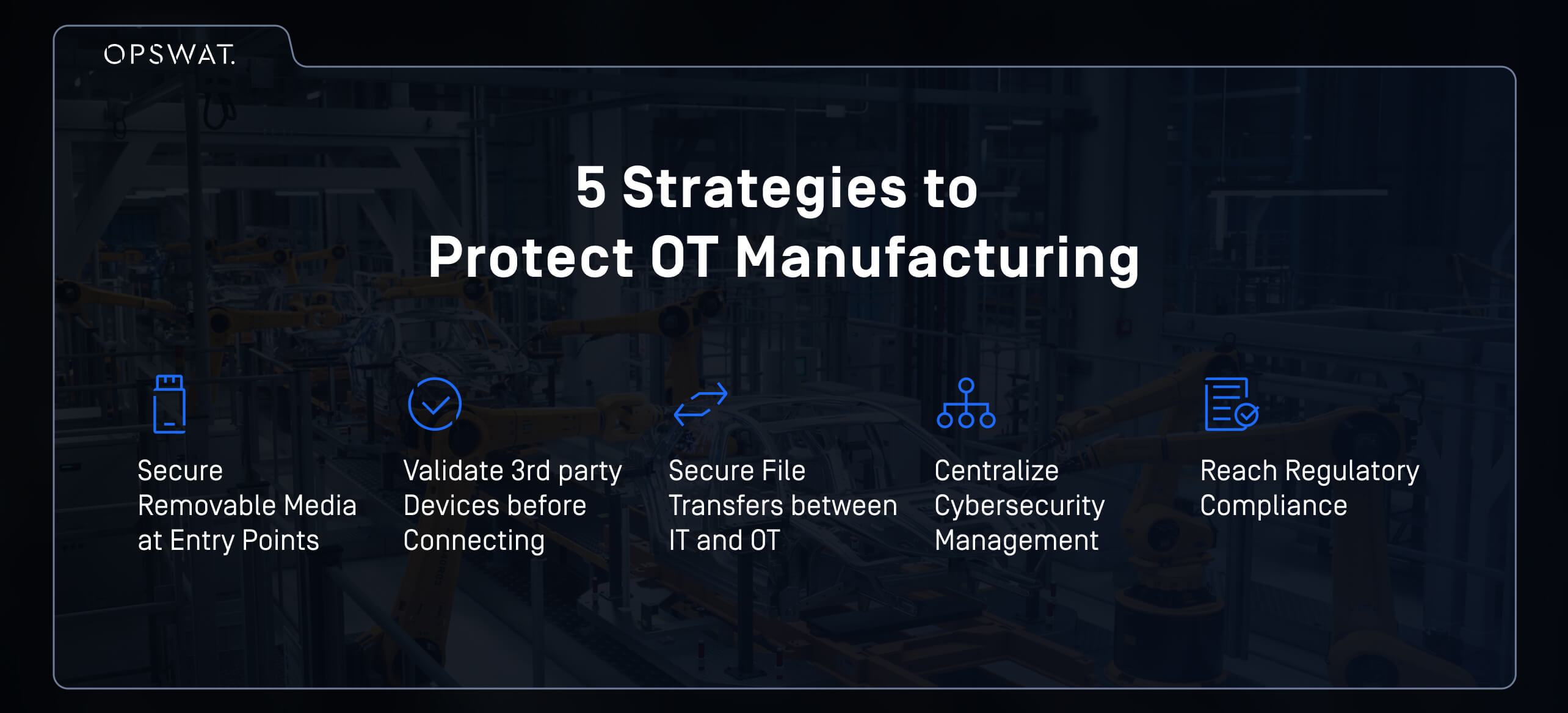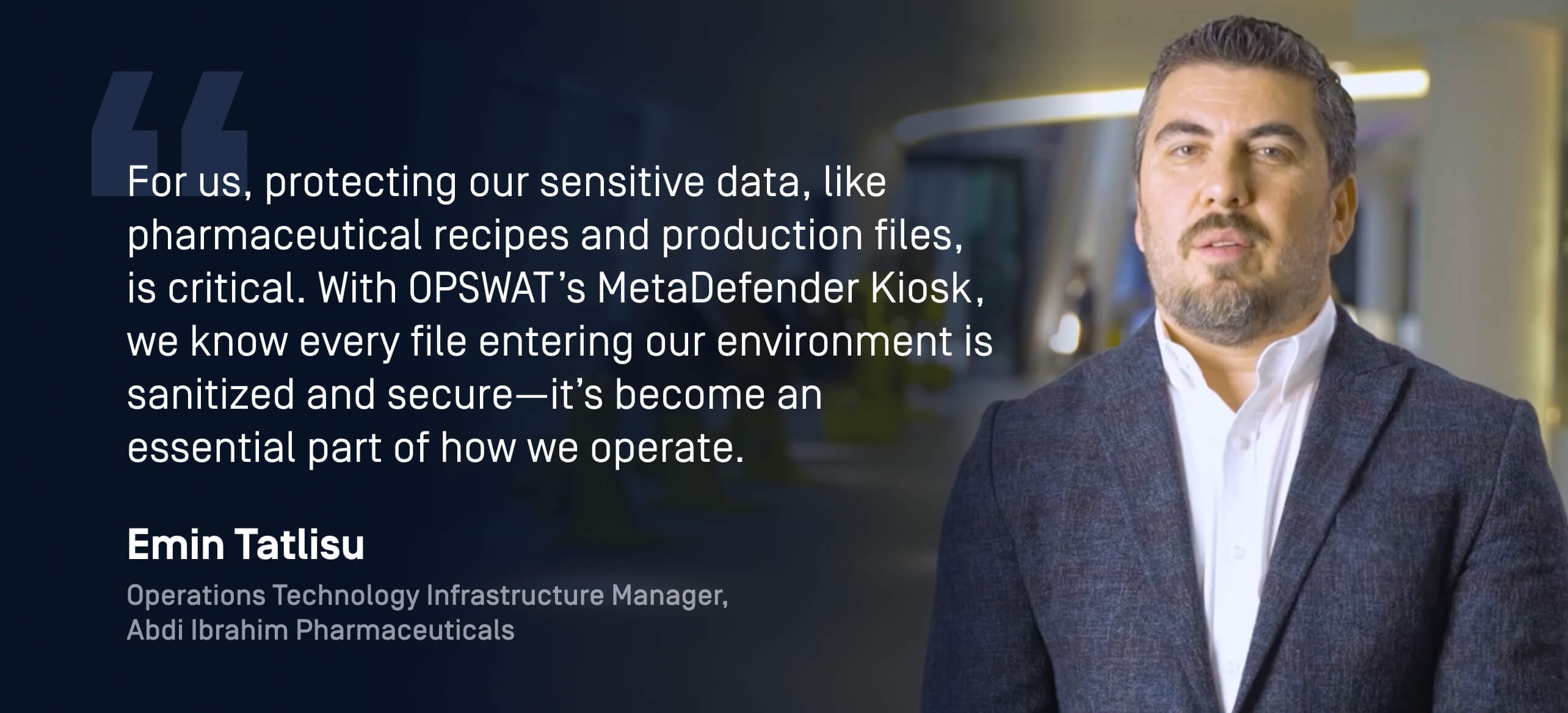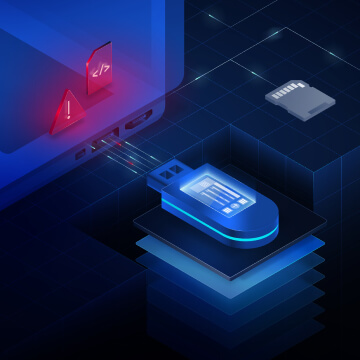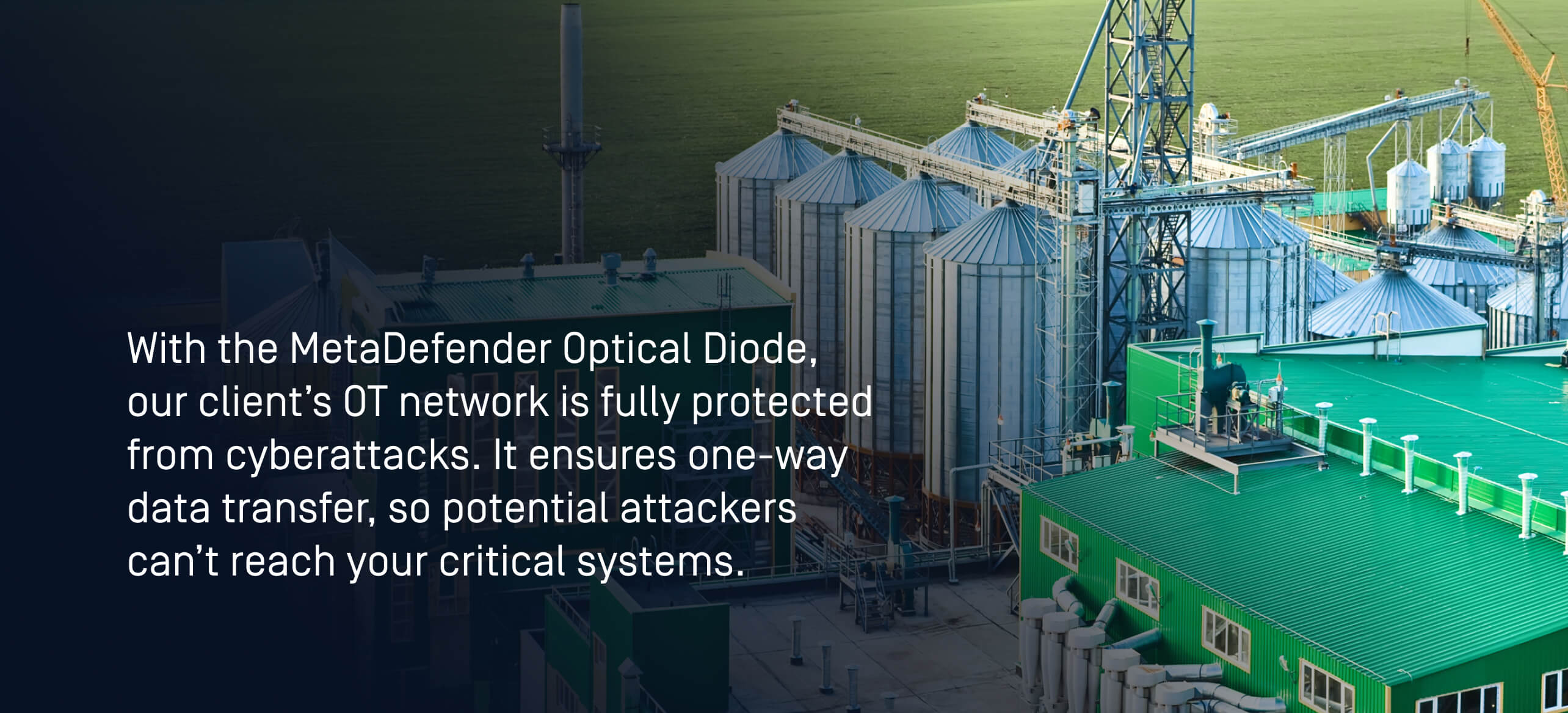لماذا يحتاج قطاع التصنيع إلى أمن إلكتروني أقوى للتكنولوجيا التشغيلية؟
وفقًا لتقرير Verizon DBIR الصادر عن شركة Verizon، ارتفعت حالات اختراق البيانات في قطاع التصنيع بنسبة 89% على أساس سنوي، حيث بلغت 1607 حالة مؤكدة مقارنة بـ 849 حالة في عام 2024. ويُعزى ذلك إلى حد كبير إلى زيادة الترابط بين أنظمة تكنولوجيا المعلومات وأنظمة التكنولوجيا التشغيلية. فالملفات مثل تصميمات التصميم بمساعدة الحاسوب أو سجلات الصيانة التنبؤية أو تحديثات الموردين تتدفق الآن عبر كلتا البيئتين، مما يخلق نقاط دخول جديدة للمهاجمين.
عندما تتعرض هذه الملفات للاختراق، فإن النتيجة لا تقتصر على فقدان البيانات فحسب، بل تتسبب في تعطل الإنتاج وتعطل العمليات ومخاطر الامتثال. نظرًا لأن وقت التشغيل أمر بالغ الأهمية في التصنيع، فحتى الحوادث الصغيرة يمكن أن تتصاعد إلى تأخيرات في سلسلة التوريد وتأثير مالي.
تسلط هذه المدونة الضوء على خمس استراتيجيات تستخدمها الشركات المصنعة لتعزيز الأمن السيبراني للتكنولوجيا التشغيلية، موضحةً عمليات النشر في العالم الحقيقي.

1. تأمين Media القابلة للإزالة عند نقاط الدخول
لا تزال محركات أقراص USB والوسائط المحمولة الأخرى مصدرًا رئيسيًا للمخاطر في بيئات التصنيع. وغالباً ما تنتقل الملفات بين الأقسام والمقاولين والموردين دون فحص مركزي، وقد تقوم فرق الإنتاج تحت الضغط بتوصيل الأجهزة دون فحص أمني. وهذا يترك مجالاً لوصول البرمجيات الخبيثة إلى أنظمة التقنيات التشغيلية الحساسة.
يتمثل الدفاع العملي في فرض فحص وتعقيم جميع الوسائط القابلة للإزالة قبل دخولها إلى الشبكة. تغطي حلول OPSWAT مراحل مختلفة من هذه العملية:

MetaDefender Kiosk™
فحص الملفات وتعقيمها قبل السماح لها بالدخول إلى شبكات OT.

MetaDefender Endpoint™
يحظر الوسائط حتى يتم استيفاء شروط الأمان مع توفير مزايا أمان إضافية.

MetaDefender Endpoint Validation™ التحقق من صحةEndpoint
التحقق من فحص الوسائط القابلة للإزالة بموجب النُهج المفروضة.

MetaDefender Media Firewall™
يفحص قطاعات التمهيد ومحتويات الملف قبل الاستخدام.

ومن الأمثلة الواقعية على ذلك شركة عبدي إبراهيم، وهي شركة عالمية لتصنيع الأدوية. فقد اعتمدت الشركة في البداية على المسح الهوائي لكنها وجدت أن الوسائط المحمولة لا تزال تشكل تهديدًا خطيرًا للبيانات الحساسة مثل الوصفات الدوائية. من خلال نشرKiosk MetaDefender Kiosk تقوم شركة عبدي إبراهيم الآن بفحص أكثر من 18,000 ملف يوميًا دون توقف. ولا يقتصر الحل على منع البرمجيات الخبيثة فحسب، بل يدعم أيضاً الامتثال التنظيمي عبر مواقع التصنيع الخاصة بها.
2. التحقق من صحة أجهزة الطرف الثالث قبل توصيلها
تخيل هذا: وصول مقاول لإجراء صيانة عاجلة في طابق الإنتاج. يحتاج جهاز الكمبيوتر المحمول الخاص به إلى الاتصال بشبكة التقنيات التشغيلية على الفور لإعادة تشغيل الأنظمة. وتحت الضغط لتقليل وقت التعطل، يتم توصيل الجهاز دون التحقق منه. هذا القرار الوحيد يمكن أن يفتح الباب أمام البرمجيات الخبيثة لتجاوز إجراءات الحماية الحالية.
يحدث هذا السيناريو في كثير من الأحيان أكثر مما تدركه معظم المؤسسات. تعد أجهزة الكمبيوتر المحمولة الخاصة بالموردين وأجهزة الطرف الثالث الأخرى من بين أكثر المسارات شيوعًا لدخول التهديدات إلى بيئات التكنولوجيا التشغيلية. إن الاعتماد على الثقة أو ضغط الوقت يخلق نقطة ضعف يمكن للمهاجمين استغلالها.
يعالج OPSWAT هذا الأمر بـ

™MetaDefender Drive
تفحص الأجهزة للتأكد من خلوها من البرمجيات الخبيثة قبل أن تتمكن من الوصول إلى بيئة التقنيات التشغيلية.

MetaDefender Endpoint Validation™ التحقق من صحةEndpoint
يتأكد من استيفاء الأجهزة لمتطلبات الفحص والتعقيم قبل منح حق الوصول.

واجهت إحدى الشركات العالمية المصنعة للسيارات هذا التحدي بالضبط. فقد كان من الصعب دمج الإعداد الأمني الحالي متعدد البائعين الخاص بهم وترك ثغرات كشفت الأنظمة الهامة. من خلال اعتماد منصة OPSWATبما في ذلك منصة MetaDefender Kiosk وتكامل إدارة الزوار، اكتسبت الشركة تحكماً موثوقاً في أجهزة الطرف الثالث. وكانت النتيجة منع أقوى للتهديدات وتقليل وقت التعطل وعملية موحدة لإدارة الأجهزة الخارجية.
3. نقل الملفات بشكل آمن بين تكنولوجيا المعلومات والتكنولوجيا التشغيلية
تعتبر عمليات نقل الملفات ضرورة روتينية في التصنيع. وغالباً ما تحتاج تحديثات Software والتصحيحات الأمنية وملفات التصميم إلى الانتقال من أنظمة تكنولوجيا المعلومات إلى بيئات التكنولوجيا التشغيلية. إذا لم يتم التحكم في عمليات النقل هذه بشكل صحيح، فيمكنها تجاوز الفحص وإدخال البرمجيات الخبيثة إلى الأنظمة الحرجة. لم تعد الثغرات الهوائية وحدها توفر الحماية الكافية، لأن معظم المصانع تتطلب الآن مستوى معيناً من الاتصال على الأقل.
يكمن التحدي في اختيار الطريقة المناسبة لكل نوع من أنواع النقل. يوفر OPSWAT خيارات متعددة، كل منها مصمم لسيناريوهات محددة:
تحديات | حل OPSWAT | المزايا |
|---|---|---|
عمليات النقل الروتينية للملفات بين تكنولوجيا المعلومات وتكنولوجيا المعلومات | نقل الملفات المُدار من MetaDefender | يعمل على أتمتة عمليات النقل وتأمينها من خلال إعادة فحص كل ملف مع منع التهديدات المتقدمة |
تدفق البيانات في اتجاه واحد مطلوب للمراقبة أو الامتثال | MetaDefender NetWall®Optical Diode] | فرض حركة البيانات أحادية الاتجاه لحماية تقنية التشغيل من التهديدات الواردة |

يطبق المصنعون حول العالم هذه الأساليب. استخدمت شركة فيتنامية لتصنيع المواد الكيميائية تدير شبكة مسطحة غير مجزأة شبكة MetaDefender Optical Diode لإنشاء وصلة أحادية الاتجاه معززة بالأجهزة. وقد أدى ذلك إلى القضاء على نقاط الضعف في الاتصال بين تكنولوجيا المعلومات والتكنولوجيا التشغيلية مع الحفاظ على الاستقرار التشغيلي.

اتخذت إحدى شركات البتروكيماويات المدرجة في قائمة فورتشن 500 مسارًا مماثلًا عندما وصلت جدران الحماية الخاصة بها إلى نهاية عمرها الافتراضي. فقد استبدلوها بصمامات OPSWAT الثنائيات الضوئية التي قللت بشكل كبير من مخاطر الهجمات الواردة، وضمنت الامتثال التنظيمي، وأرست استقراراً طويل الأمد لأنظمة الشركة الحساسة.
4. مركزية عمليات وإدارة الأمن السيبراني
في العديد من مؤسسات التصنيع، يتعامل كل موقع مع الأمن السيبراني بطريقته الخاصة. قد يكون لدى أحد المصانع كشك مسح ضوئي، وقد يعتمد موقع آخر على برامج مكافحة الفيروسات، وقد يفتقر موقع ثالث إلى عمليات واضحة تماماً. هذا التجزؤ يجعل من الصعب تطبيق السياسات بشكل متسق، أو الاستجابة للحوادث، أو الاستعداد لعمليات التدقيق.
إن مركزية العمليات تحل هذه المشكلة. من خلالCentral Management لـ My OPSWAT يمكن لفرق الأمن إدارة الأجهزة المسجلة وفرض سياسات أمان نقطة النهاية ومراقبة تدفق البيانات من منصة واحدة. تُعد هذه الرؤية ضرورية في البيئات المعقدة التي تشترك فيها العديد من المصانع والمقاولين والأجهزة.
المزايا الرئيسية
- تطبيق السياسة بشكل متسق عبر جميع المواقع ونقاط النهاية
- رؤية في الوقت الفعلي لاستخدام الجهاز وأنماط الوصول إليه
- تقارير الامتثال المبسطة مع سجلات التدقيق المركزية
- استجابة أسرع للحوادث بسبب المراقبة الموحدة
من خلال توحيد إدارة الأمان، لا تقلل الشركات المصنعة من التعقيدات فحسب، بل تعزز أيضًا قدرتها على الحفاظ على وقت التشغيل والامتثال التنظيمي.
5. المواءمة مع أطر الامتثال الدولية
يجب أن تعمل الشركات المصنعة بموجب أطر تنظيمية متعددة تحكم الأمن السيبراني وسلامة البيانات والسلامة التشغيلية. ويتطلب اجتياز التدقيق دليلاً واضحاً على وجود ضوابط، ولكن الاعتماد على جداول البيانات والسجلات المجزأة يجعل هذا الأمر صعباً. يضمن التوافق مع المعايير المعترف بها كلاً من الامتثال والمرونة الأقوى ضد التهديدات.
تشمل الأطر الشائعة ما يلي:
- ISO 27001 لإدارة أمن المعلومات
- IEC 62443 لأمن نظام التحكم الصناعي IEC 62443 لأمن نظام التحكم الصناعي
- توجيه NIS2 الخاص بالخدمات الأساسية الأوروبية، بما في ذلك التصنيع
- الناتج المحلي الإجمالي لحماية البيانات والخصوصية
- ممارسات التصنيع الجيدة وممارسات التصنيع الجيدة لإدارة الغذاء والدواء الأمريكية (FDA) و FSMA لتصنيع الأغذية والأدوية
تدعم حلول OPSWAT الامتثال من خلال توفير تطبيق مركزي للسياسة وسجلات يمكن تتبعها وضوابط آمنة لتدفق البيانات.

واجهت إحدى الشركات العالمية المتخصصة في الزراعة والأغذية هذا التحدي عندما قامت بتوصيل أنظمة تكنولوجيا المعلومات والتكنولوجيا التشغيلية بالهواء لحماية العمليات الحيوية. وعلى الرغم من أن هذا الأمر كان آمنًا، إلا أنه منع فرق العمل من الوصول إلى بيانات التكنولوجيا التشغيلية اللازمة للتخطيط. ومن خلال نشر نظامMetaDefender Optical Diode™، مكّنهم ذلك من تدفق البيانات أحادي الاتجاه من تكنولوجيا التشغيل إلى تكنولوجيا المعلومات. وقد أدى ذلك إلى حماية أصول التكنولوجيا التشغيلية المعرضة للخطر، ومنح الفرق إمكانية الرؤية في الوقت الفعلي، وساعد المؤسسة على تلبية متطلبات إدارة الأغذية والعقاقير وهيئة الغذاء والدواء الأمريكية.
بناء المرونة السيبرانية في التصنيع
لا يزال قطاع التصنيع من أكثر القطاعات المستهدفة بالهجمات السيبرانية، وتتجاوز المخاطر التي يتعرض لها البيانات إلى وقت تشغيل الإنتاج وسلامة العمال. تُظهر الاستراتيجيات الخمس الموضحة هنا كيف يمكن للمصنعين تعزيز المرونة ضد هذه التهديدات.
هذه ليست مجرد نظريات. فالشركات في قطاعات السيارات والأدوية والبتروكيماويات والبتروكيماويات والزراعة تطبق بالفعل حلول OPSWAT لتأمين عملياتها، مما يجعل الإنتاج سلسًا اليوم وجاهزًا للتعامل مع متطلبات الغد.
هل أنت مستعد لمعرفة المزيد؟
لاستكشاف عمليات النشر في العالم الحقيقي هذه بمزيد من التفصيل، قم بتنزيل كتابنا الإلكتروني "عمليات النشر المثبتة في التصنيع".

